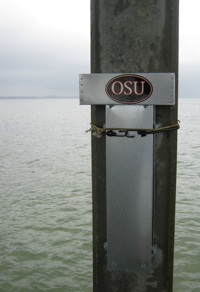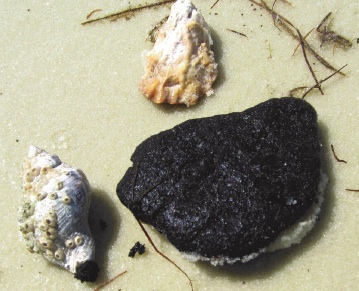We sampled the polycyclic aromatic hydrocarbons (PAHs) in air and water in the Gulf of Mexico before and after the Deepwater Horizon oil spill in 2010. The level of PAHs in crude oil varies between 0.2 and 7%, depending on location. Although this seems like a small percent, PAHs are a significant toxicological health concern.
Public Information and Resources
Gulf of Mexico Coastal Air and Water Pollutant Research
WHY ARE WE SAMPLING?
The use of complementary bio-analytical tools that quantify bioavailability processes is important to understand disasters such as oil spill risk. The project goals will be to use air and water passive sampler devices (PSDs) in the Gulf of Mexico before, during and post impact from the Deepwater Horizon Spill of spring 2010.
|
The PSDs are biological response indicator devices for gauging environmental stressors (BRIDGES) developed as part of a Superfund Program grant (Project 4). They bridge environmental exposure and biological response/effect. They can provide for rapid turnaround of data.
View Training Videos of the passive sampling devices (English and Spanish)
The PSDs sequester PAHs, oxygenated PAHs (OPAHs) as well as other organic contaminants. OPAHs are potentially more mobile, bioavailable and/or persistent than PAHs.
There is growing evidence that OPAHs have important toxicological significance. The principle sources of OPAHs in aquatic systems are from photo-reactions and microbial degradation of PAHs.
Dispersants that increase bioavailability coupled with sites exposed to UV may increase OPAHs.
|

Passive air sampler device on dock in the Gulf of Mexico. |
WHAT IS OUR EXPERTISE?
Dr. Kim Anderson, (Project Leader, PAH Fate and Exposure; Core Leader, Chemical Mixtures Core) has helped to firmly establish the PSD bio-analytical approach to assess spatial and temporal changes in the bioavailable fraction of contaminants at Gulf of Mexico contaminated sites. Dr. Anderson is teaming with Dr. Robyn Tanguay (Project Leader, Predicting PAH Mixtures Toxicity; Co-I, Project 4), who has developed the zebrafish aquatic model to define the mechanism by which environmental bioavailable chemicals from air and waters affected by the Deepwater Horizon oil spill produce developmental toxicity.
We are now poised to address important questions to bridge measurements of environmental levels and biological responses which would adversely impact human health. This work is timely, innovative, and relevant in that we are addressing the gap between environmental exposure from oil spills and biological responses by use of a time integrated, bio-analytical system for selectively measuring the environmental exposure that elicits a toxic response.
Other important SRP expertise for this project include:
WHERE ARE WE SAMPLING?

Alabama sampling site |
We have established regional contacts and sampling locations in:
-
Pensacola, Florida
-
Gulf Shores, Alabama
-
Gulfport, Mississippi
-
Grand Isle, Louisiana
View Map
|
DESIRED OUTCOMES
-
The successful completion of this project will result in the quick development of data from novel bio-analytical tools from the Deepwater Horizon spill from Louisiana to Florida.
-
The technology and approach will be applicable to other environmental disasters and with other responsive models.
-
The bio-analytical tools will predicatively bridge environmental measurements with biological responses which will reduce uncertainties in risk assessments.
-
This study would be the first assessment of the concentrations and spatial and temporal distributions of bioavailable oxygenated PAHs in an active oil spill. Furthermore, it would be the first large-scale in situ study of the association between bioavailable PAHs and OPAHs in air and water pre, during and post a national disaster oil spill.
-
The potential for increased toxicity of PAHs when combined with other contaminants present in the Gulf including dispersants will have stand alone informational health value.
The SRP Gulf sampling is a project of the Bioavailable Air and Water Passive Sampling Gear for Gulf of Mexico and Deepwater Horizon Oil Spill (BRIDGES: Biological Response Indicator Devices for Gauging Environmental Stressors) The project is funded in part by NIEHS Superfund Research Program Grant # P42ES016465 and NIEHS Environmental Health Sciences Center Grant # P30ES000210

Pictured left to right: Kevin Hobbie, Kim Anderson, Sarah Allan, Lane Tidwell



